McDonald's Business Report: Organisation, Leadership & Globalisation
VerifiedAdded on 2024/05/31
|13
|2969
|500
Report
AI Summary
This business report delves into McDonald's operations, focusing on the Poland market. It explores the three levels of organisation and management, detailing their responsibilities and the impact of globalisation on McDonald's business strategies. The report analyses leadership styles, particularly Adam Pienkowski's participative approach, and discusses McDonald's Corporate Social Responsibility (CSR) initiatives, including economic, legal, ethical, and philanthropic responsibilities. It further examines the effects of globalisation on McDonald's growth and revenue, highlighting the company's ability to leverage global opportunities. The report concludes with recommendations for improvement to achieve further growth and development in McDonald’s Poland venture, offering insights into how the company can enhance its market position and operational efficiency.
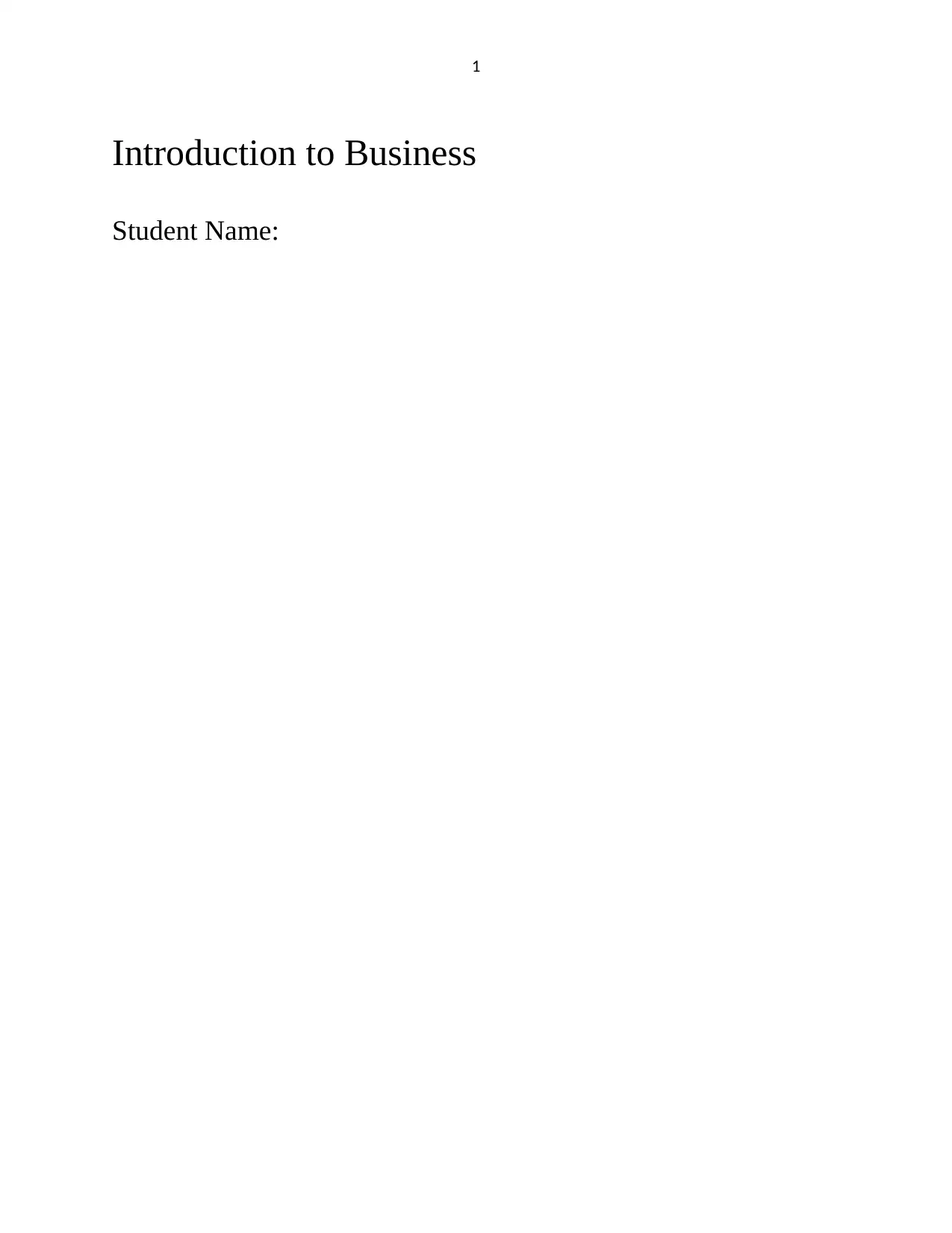
1
Introduction to Business
Student Name:
Introduction to Business
Student Name:
Paraphrase This Document
Need a fresh take? Get an instant paraphrase of this document with our AI Paraphraser
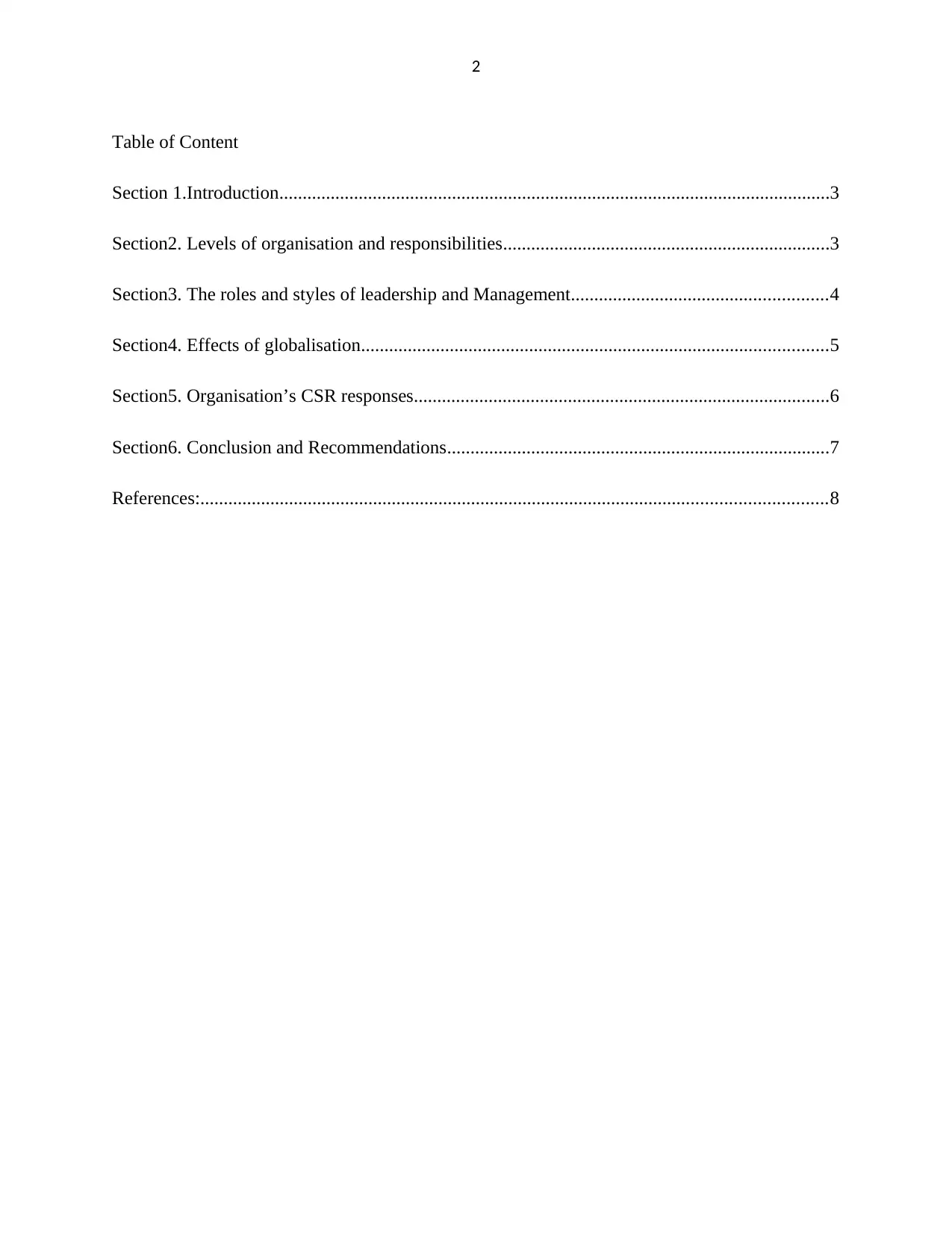
2
Table of Content
Section 1.Introduction......................................................................................................................3
Section2. Levels of organisation and responsibilities......................................................................3
Section3. The roles and styles of leadership and Management.......................................................4
Section4. Effects of globalisation....................................................................................................5
Section5. Organisation’s CSR responses.........................................................................................6
Section6. Conclusion and Recommendations..................................................................................7
References:......................................................................................................................................8
Table of Content
Section 1.Introduction......................................................................................................................3
Section2. Levels of organisation and responsibilities......................................................................3
Section3. The roles and styles of leadership and Management.......................................................4
Section4. Effects of globalisation....................................................................................................5
Section5. Organisation’s CSR responses.........................................................................................6
Section6. Conclusion and Recommendations..................................................................................7
References:......................................................................................................................................8
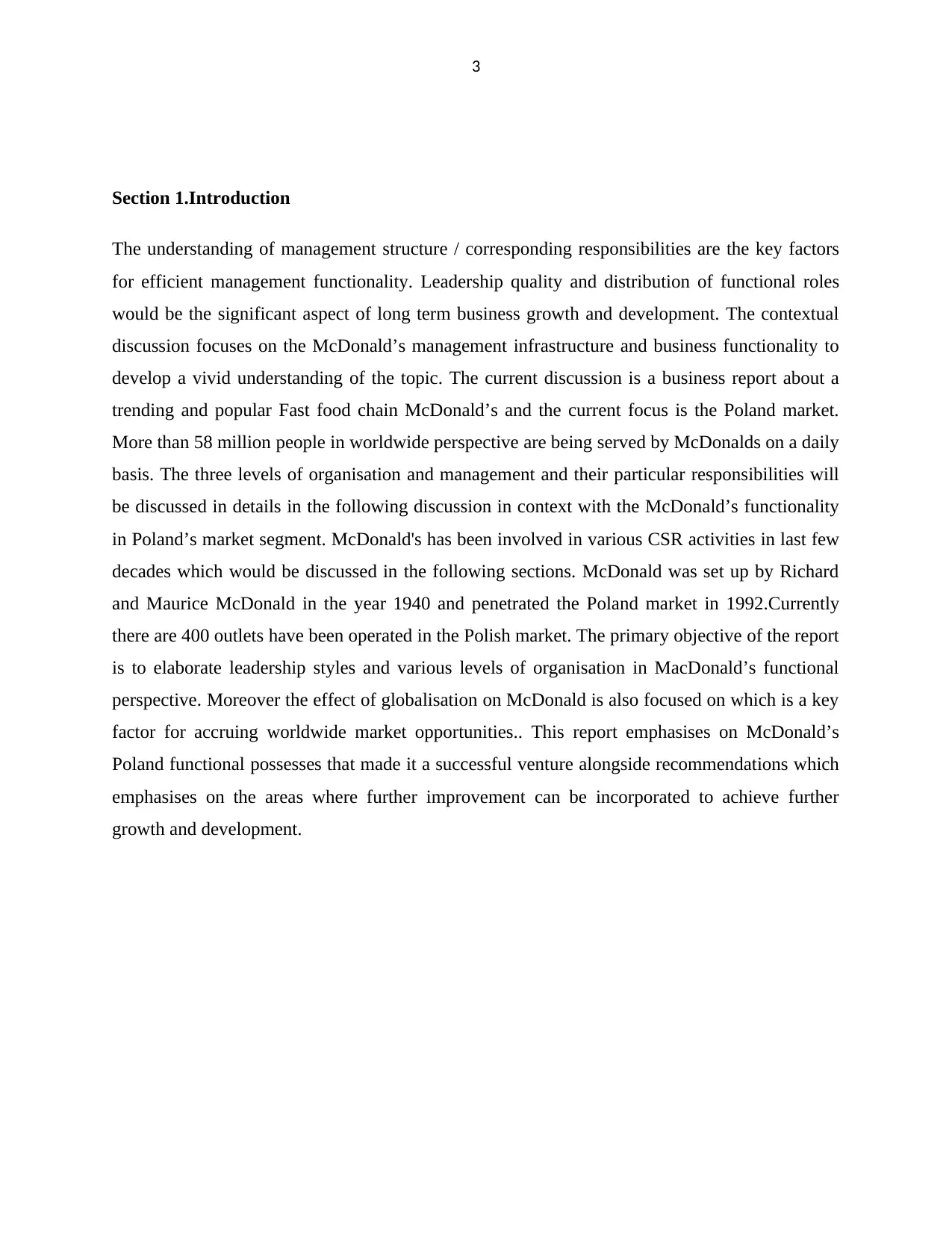
3
Section 1.Introduction
The understanding of management structure / corresponding responsibilities are the key factors
for efficient management functionality. Leadership quality and distribution of functional roles
would be the significant aspect of long term business growth and development. The contextual
discussion focuses on the McDonald’s management infrastructure and business functionality to
develop a vivid understanding of the topic. The current discussion is a business report about a
trending and popular Fast food chain McDonald’s and the current focus is the Poland market.
More than 58 million people in worldwide perspective are being served by McDonalds on a daily
basis. The three levels of organisation and management and their particular responsibilities will
be discussed in details in the following discussion in context with the McDonald’s functionality
in Poland’s market segment. McDonald's has been involved in various CSR activities in last few
decades which would be discussed in the following sections. McDonald was set up by Richard
and Maurice McDonald in the year 1940 and penetrated the Poland market in 1992.Currently
there are 400 outlets have been operated in the Polish market. The primary objective of the report
is to elaborate leadership styles and various levels of organisation in MacDonald’s functional
perspective. Moreover the effect of globalisation on McDonald is also focused on which is a key
factor for accruing worldwide market opportunities.. This report emphasises on McDonald’s
Poland functional possesses that made it a successful venture alongside recommendations which
emphasises on the areas where further improvement can be incorporated to achieve further
growth and development.
Section 1.Introduction
The understanding of management structure / corresponding responsibilities are the key factors
for efficient management functionality. Leadership quality and distribution of functional roles
would be the significant aspect of long term business growth and development. The contextual
discussion focuses on the McDonald’s management infrastructure and business functionality to
develop a vivid understanding of the topic. The current discussion is a business report about a
trending and popular Fast food chain McDonald’s and the current focus is the Poland market.
More than 58 million people in worldwide perspective are being served by McDonalds on a daily
basis. The three levels of organisation and management and their particular responsibilities will
be discussed in details in the following discussion in context with the McDonald’s functionality
in Poland’s market segment. McDonald's has been involved in various CSR activities in last few
decades which would be discussed in the following sections. McDonald was set up by Richard
and Maurice McDonald in the year 1940 and penetrated the Poland market in 1992.Currently
there are 400 outlets have been operated in the Polish market. The primary objective of the report
is to elaborate leadership styles and various levels of organisation in MacDonald’s functional
perspective. Moreover the effect of globalisation on McDonald is also focused on which is a key
factor for accruing worldwide market opportunities.. This report emphasises on McDonald’s
Poland functional possesses that made it a successful venture alongside recommendations which
emphasises on the areas where further improvement can be incorporated to achieve further
growth and development.
⊘ This is a preview!⊘
Do you want full access?
Subscribe today to unlock all pages.

Trusted by 1+ million students worldwide
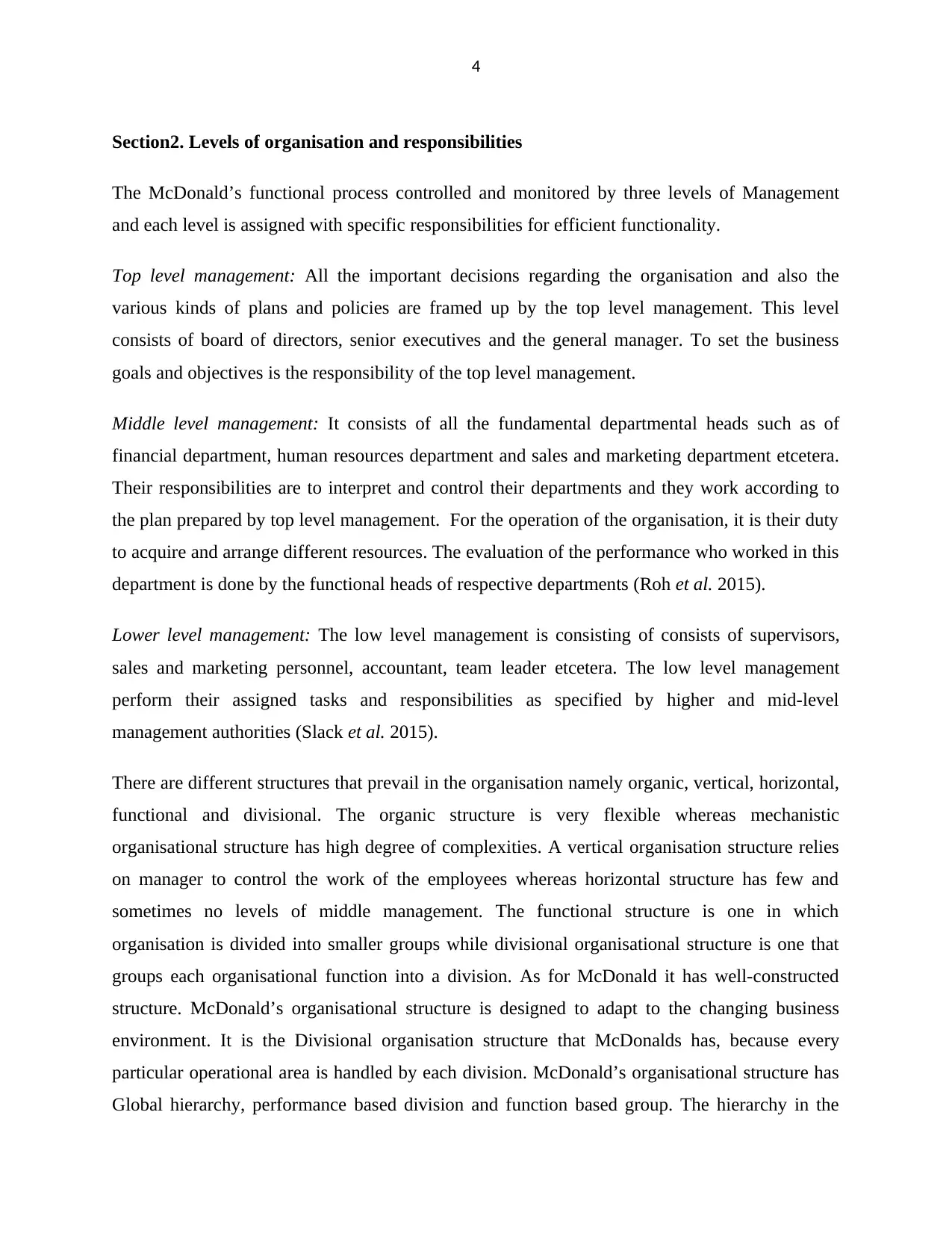
4
Section2. Levels of organisation and responsibilities
The McDonald’s functional process controlled and monitored by three levels of Management
and each level is assigned with specific responsibilities for efficient functionality.
Top level management: All the important decisions regarding the organisation and also the
various kinds of plans and policies are framed up by the top level management. This level
consists of board of directors, senior executives and the general manager. To set the business
goals and objectives is the responsibility of the top level management.
Middle level management: It consists of all the fundamental departmental heads such as of
financial department, human resources department and sales and marketing department etcetera.
Their responsibilities are to interpret and control their departments and they work according to
the plan prepared by top level management. For the operation of the organisation, it is their duty
to acquire and arrange different resources. The evaluation of the performance who worked in this
department is done by the functional heads of respective departments (Roh et al. 2015).
Lower level management: The low level management is consisting of consists of supervisors,
sales and marketing personnel, accountant, team leader etcetera. The low level management
perform their assigned tasks and responsibilities as specified by higher and mid-level
management authorities (Slack et al. 2015).
There are different structures that prevail in the organisation namely organic, vertical, horizontal,
functional and divisional. The organic structure is very flexible whereas mechanistic
organisational structure has high degree of complexities. A vertical organisation structure relies
on manager to control the work of the employees whereas horizontal structure has few and
sometimes no levels of middle management. The functional structure is one in which
organisation is divided into smaller groups while divisional organisational structure is one that
groups each organisational function into a division. As for McDonald it has well-constructed
structure. McDonald’s organisational structure is designed to adapt to the changing business
environment. It is the Divisional organisation structure that McDonalds has, because every
particular operational area is handled by each division. McDonald’s organisational structure has
Global hierarchy, performance based division and function based group. The hierarchy in the
Section2. Levels of organisation and responsibilities
The McDonald’s functional process controlled and monitored by three levels of Management
and each level is assigned with specific responsibilities for efficient functionality.
Top level management: All the important decisions regarding the organisation and also the
various kinds of plans and policies are framed up by the top level management. This level
consists of board of directors, senior executives and the general manager. To set the business
goals and objectives is the responsibility of the top level management.
Middle level management: It consists of all the fundamental departmental heads such as of
financial department, human resources department and sales and marketing department etcetera.
Their responsibilities are to interpret and control their departments and they work according to
the plan prepared by top level management. For the operation of the organisation, it is their duty
to acquire and arrange different resources. The evaluation of the performance who worked in this
department is done by the functional heads of respective departments (Roh et al. 2015).
Lower level management: The low level management is consisting of consists of supervisors,
sales and marketing personnel, accountant, team leader etcetera. The low level management
perform their assigned tasks and responsibilities as specified by higher and mid-level
management authorities (Slack et al. 2015).
There are different structures that prevail in the organisation namely organic, vertical, horizontal,
functional and divisional. The organic structure is very flexible whereas mechanistic
organisational structure has high degree of complexities. A vertical organisation structure relies
on manager to control the work of the employees whereas horizontal structure has few and
sometimes no levels of middle management. The functional structure is one in which
organisation is divided into smaller groups while divisional organisational structure is one that
groups each organisational function into a division. As for McDonald it has well-constructed
structure. McDonald’s organisational structure is designed to adapt to the changing business
environment. It is the Divisional organisation structure that McDonalds has, because every
particular operational area is handled by each division. McDonald’s organisational structure has
Global hierarchy, performance based division and function based group. The hierarchy in the
Paraphrase This Document
Need a fresh take? Get an instant paraphrase of this document with our AI Paraphraser
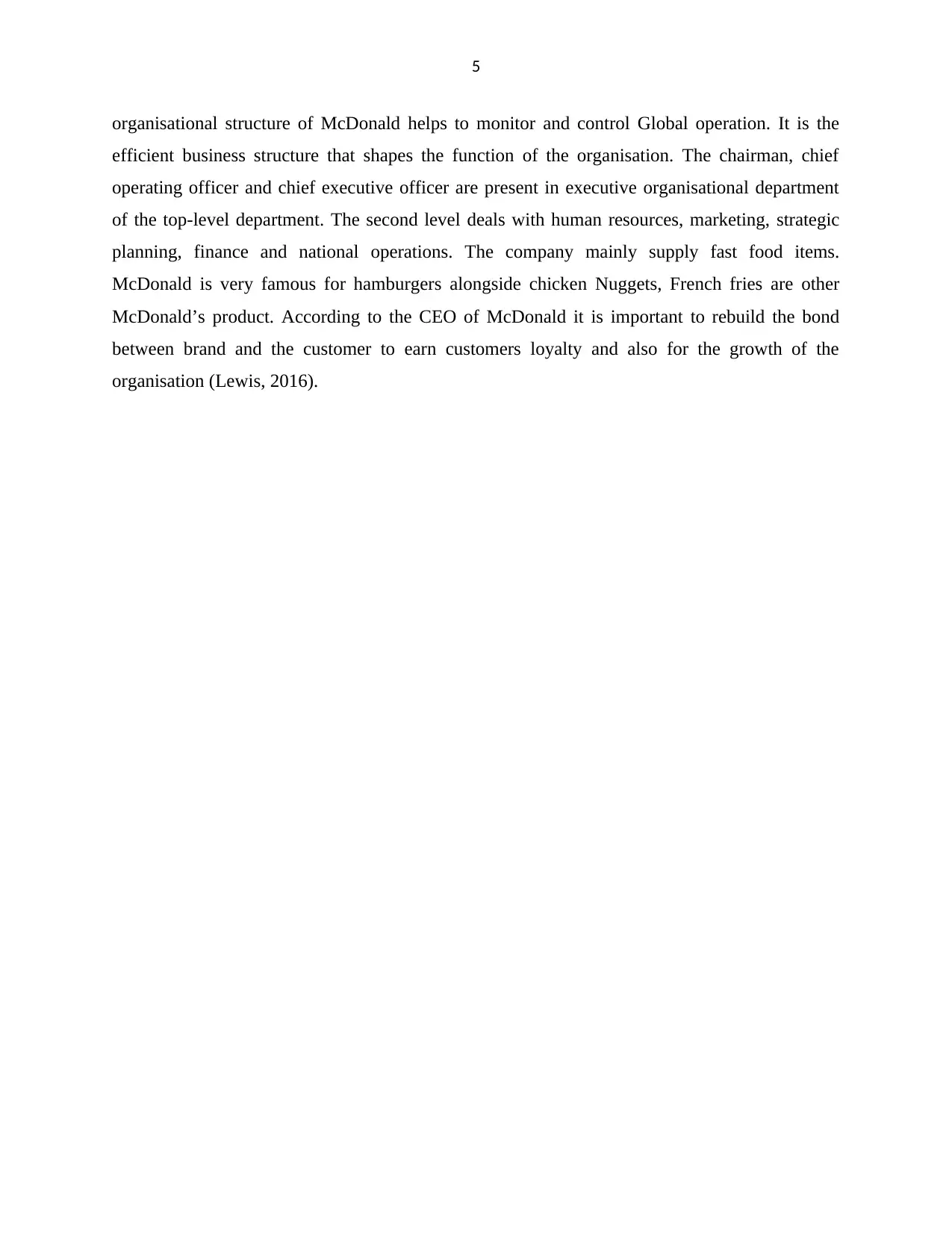
5
organisational structure of McDonald helps to monitor and control Global operation. It is the
efficient business structure that shapes the function of the organisation. The chairman, chief
operating officer and chief executive officer are present in executive organisational department
of the top-level department. The second level deals with human resources, marketing, strategic
planning, finance and national operations. The company mainly supply fast food items.
McDonald is very famous for hamburgers alongside chicken Nuggets, French fries are other
McDonald’s product. According to the CEO of McDonald it is important to rebuild the bond
between brand and the customer to earn customers loyalty and also for the growth of the
organisation (Lewis, 2016).
organisational structure of McDonald helps to monitor and control Global operation. It is the
efficient business structure that shapes the function of the organisation. The chairman, chief
operating officer and chief executive officer are present in executive organisational department
of the top-level department. The second level deals with human resources, marketing, strategic
planning, finance and national operations. The company mainly supply fast food items.
McDonald is very famous for hamburgers alongside chicken Nuggets, French fries are other
McDonald’s product. According to the CEO of McDonald it is important to rebuild the bond
between brand and the customer to earn customers loyalty and also for the growth of the
organisation (Lewis, 2016).
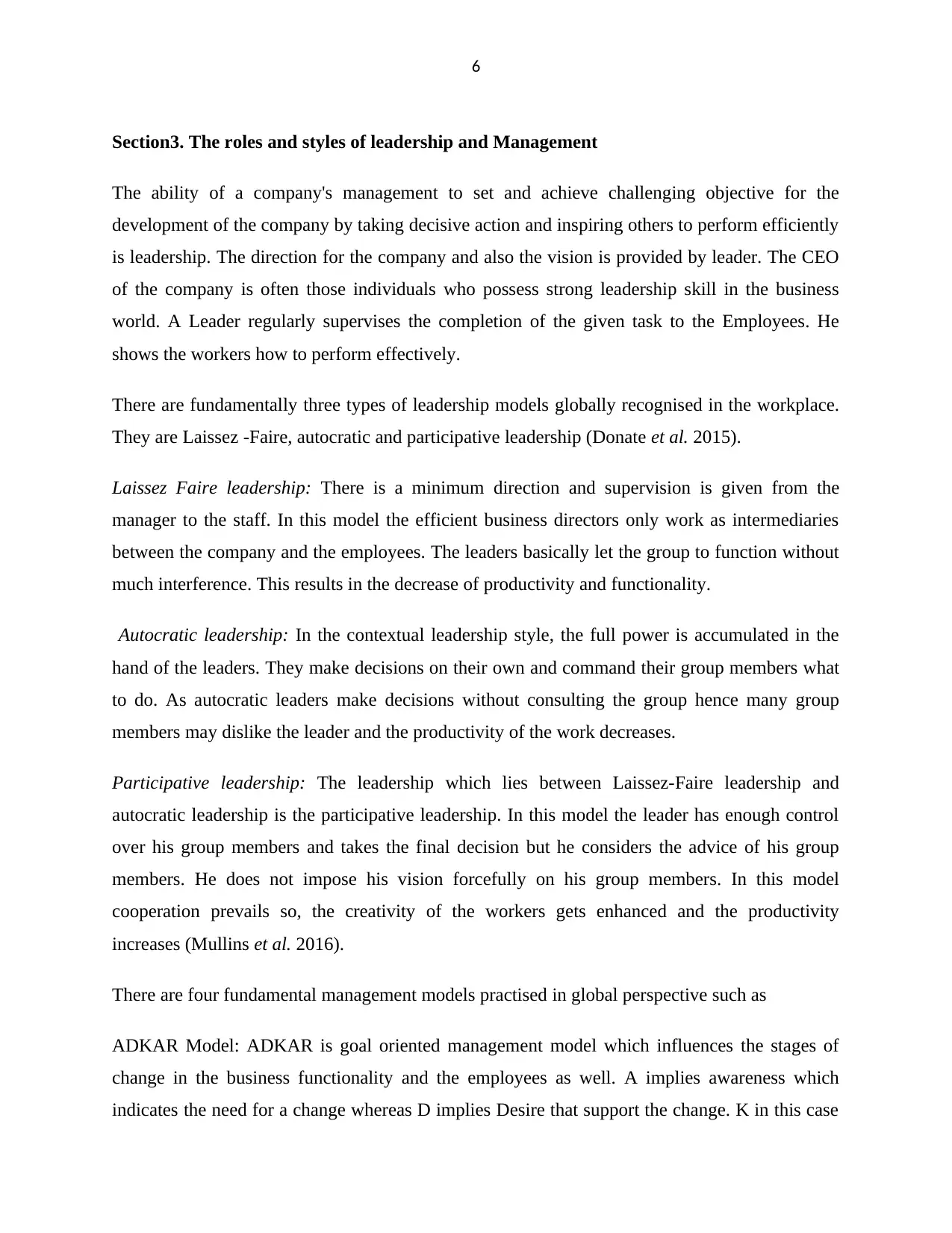
6
Section3. The roles and styles of leadership and Management
The ability of a company's management to set and achieve challenging objective for the
development of the company by taking decisive action and inspiring others to perform efficiently
is leadership. The direction for the company and also the vision is provided by leader. The CEO
of the company is often those individuals who possess strong leadership skill in the business
world. A Leader regularly supervises the completion of the given task to the Employees. He
shows the workers how to perform effectively.
There are fundamentally three types of leadership models globally recognised in the workplace.
They are Laissez -Faire, autocratic and participative leadership (Donate et al. 2015).
Laissez Faire leadership: There is a minimum direction and supervision is given from the
manager to the staff. In this model the efficient business directors only work as intermediaries
between the company and the employees. The leaders basically let the group to function without
much interference. This results in the decrease of productivity and functionality.
Autocratic leadership: In the contextual leadership style, the full power is accumulated in the
hand of the leaders. They make decisions on their own and command their group members what
to do. As autocratic leaders make decisions without consulting the group hence many group
members may dislike the leader and the productivity of the work decreases.
Participative leadership: The leadership which lies between Laissez-Faire leadership and
autocratic leadership is the participative leadership. In this model the leader has enough control
over his group members and takes the final decision but he considers the advice of his group
members. He does not impose his vision forcefully on his group members. In this model
cooperation prevails so, the creativity of the workers gets enhanced and the productivity
increases (Mullins et al. 2016).
There are four fundamental management models practised in global perspective such as
ADKAR Model: ADKAR is goal oriented management model which influences the stages of
change in the business functionality and the employees as well. A implies awareness which
indicates the need for a change whereas D implies Desire that support the change. K in this case
Section3. The roles and styles of leadership and Management
The ability of a company's management to set and achieve challenging objective for the
development of the company by taking decisive action and inspiring others to perform efficiently
is leadership. The direction for the company and also the vision is provided by leader. The CEO
of the company is often those individuals who possess strong leadership skill in the business
world. A Leader regularly supervises the completion of the given task to the Employees. He
shows the workers how to perform effectively.
There are fundamentally three types of leadership models globally recognised in the workplace.
They are Laissez -Faire, autocratic and participative leadership (Donate et al. 2015).
Laissez Faire leadership: There is a minimum direction and supervision is given from the
manager to the staff. In this model the efficient business directors only work as intermediaries
between the company and the employees. The leaders basically let the group to function without
much interference. This results in the decrease of productivity and functionality.
Autocratic leadership: In the contextual leadership style, the full power is accumulated in the
hand of the leaders. They make decisions on their own and command their group members what
to do. As autocratic leaders make decisions without consulting the group hence many group
members may dislike the leader and the productivity of the work decreases.
Participative leadership: The leadership which lies between Laissez-Faire leadership and
autocratic leadership is the participative leadership. In this model the leader has enough control
over his group members and takes the final decision but he considers the advice of his group
members. He does not impose his vision forcefully on his group members. In this model
cooperation prevails so, the creativity of the workers gets enhanced and the productivity
increases (Mullins et al. 2016).
There are four fundamental management models practised in global perspective such as
ADKAR Model: ADKAR is goal oriented management model which influences the stages of
change in the business functionality and the employees as well. A implies awareness which
indicates the need for a change whereas D implies Desire that support the change. K in this case
⊘ This is a preview!⊘
Do you want full access?
Subscribe today to unlock all pages.

Trusted by 1+ million students worldwide
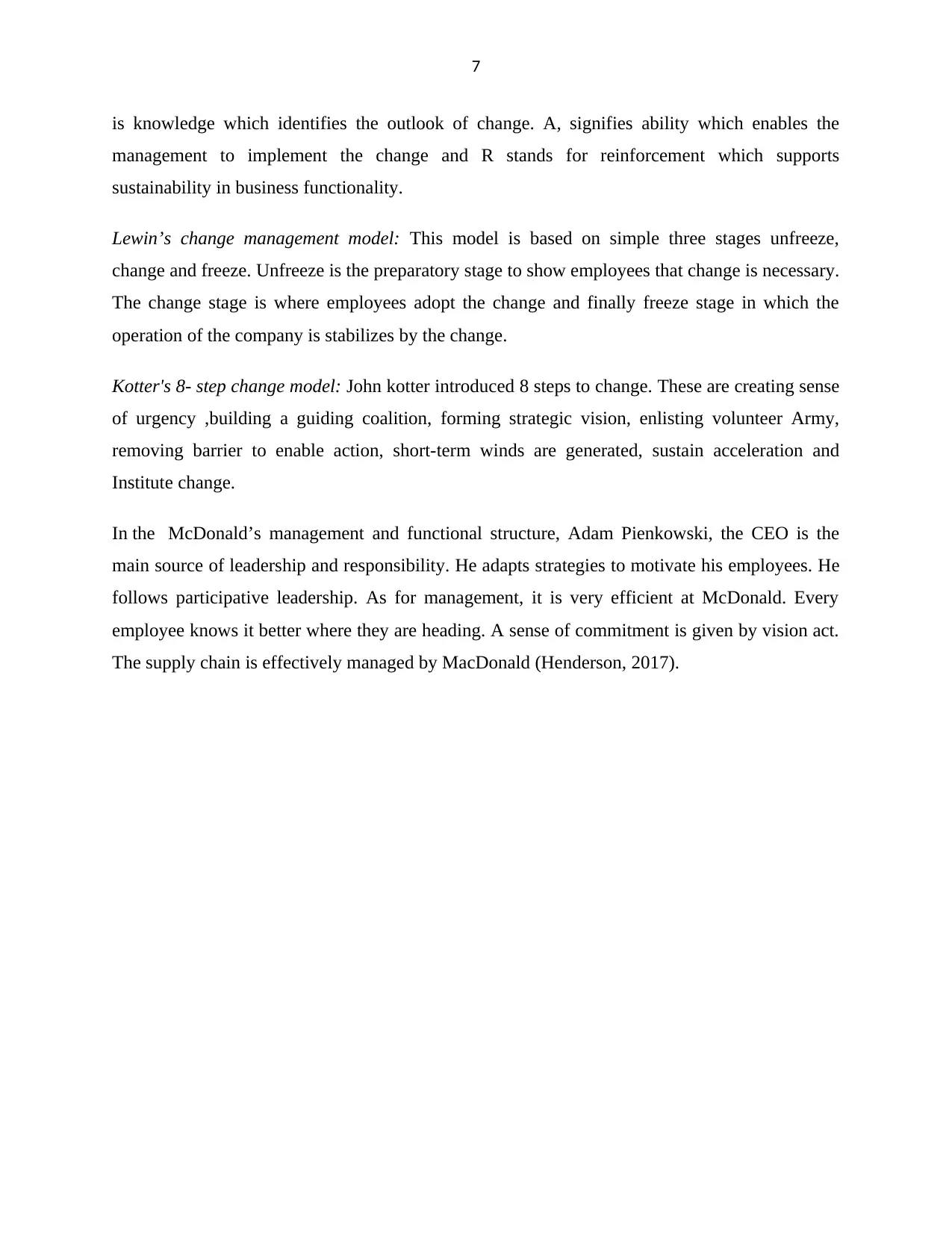
7
is knowledge which identifies the outlook of change. A, signifies ability which enables the
management to implement the change and R stands for reinforcement which supports
sustainability in business functionality.
Lewin’s change management model: This model is based on simple three stages unfreeze,
change and freeze. Unfreeze is the preparatory stage to show employees that change is necessary.
The change stage is where employees adopt the change and finally freeze stage in which the
operation of the company is stabilizes by the change.
Kotter's 8- step change model: John kotter introduced 8 steps to change. These are creating sense
of urgency ,building a guiding coalition, forming strategic vision, enlisting volunteer Army,
removing barrier to enable action, short-term winds are generated, sustain acceleration and
Institute change.
In the McDonald’s management and functional structure, Adam Pienkowski, the CEO is the
main source of leadership and responsibility. He adapts strategies to motivate his employees. He
follows participative leadership. As for management, it is very efficient at McDonald. Every
employee knows it better where they are heading. A sense of commitment is given by vision act.
The supply chain is effectively managed by MacDonald (Henderson, 2017).
is knowledge which identifies the outlook of change. A, signifies ability which enables the
management to implement the change and R stands for reinforcement which supports
sustainability in business functionality.
Lewin’s change management model: This model is based on simple three stages unfreeze,
change and freeze. Unfreeze is the preparatory stage to show employees that change is necessary.
The change stage is where employees adopt the change and finally freeze stage in which the
operation of the company is stabilizes by the change.
Kotter's 8- step change model: John kotter introduced 8 steps to change. These are creating sense
of urgency ,building a guiding coalition, forming strategic vision, enlisting volunteer Army,
removing barrier to enable action, short-term winds are generated, sustain acceleration and
Institute change.
In the McDonald’s management and functional structure, Adam Pienkowski, the CEO is the
main source of leadership and responsibility. He adapts strategies to motivate his employees. He
follows participative leadership. As for management, it is very efficient at McDonald. Every
employee knows it better where they are heading. A sense of commitment is given by vision act.
The supply chain is effectively managed by MacDonald (Henderson, 2017).
Paraphrase This Document
Need a fresh take? Get an instant paraphrase of this document with our AI Paraphraser
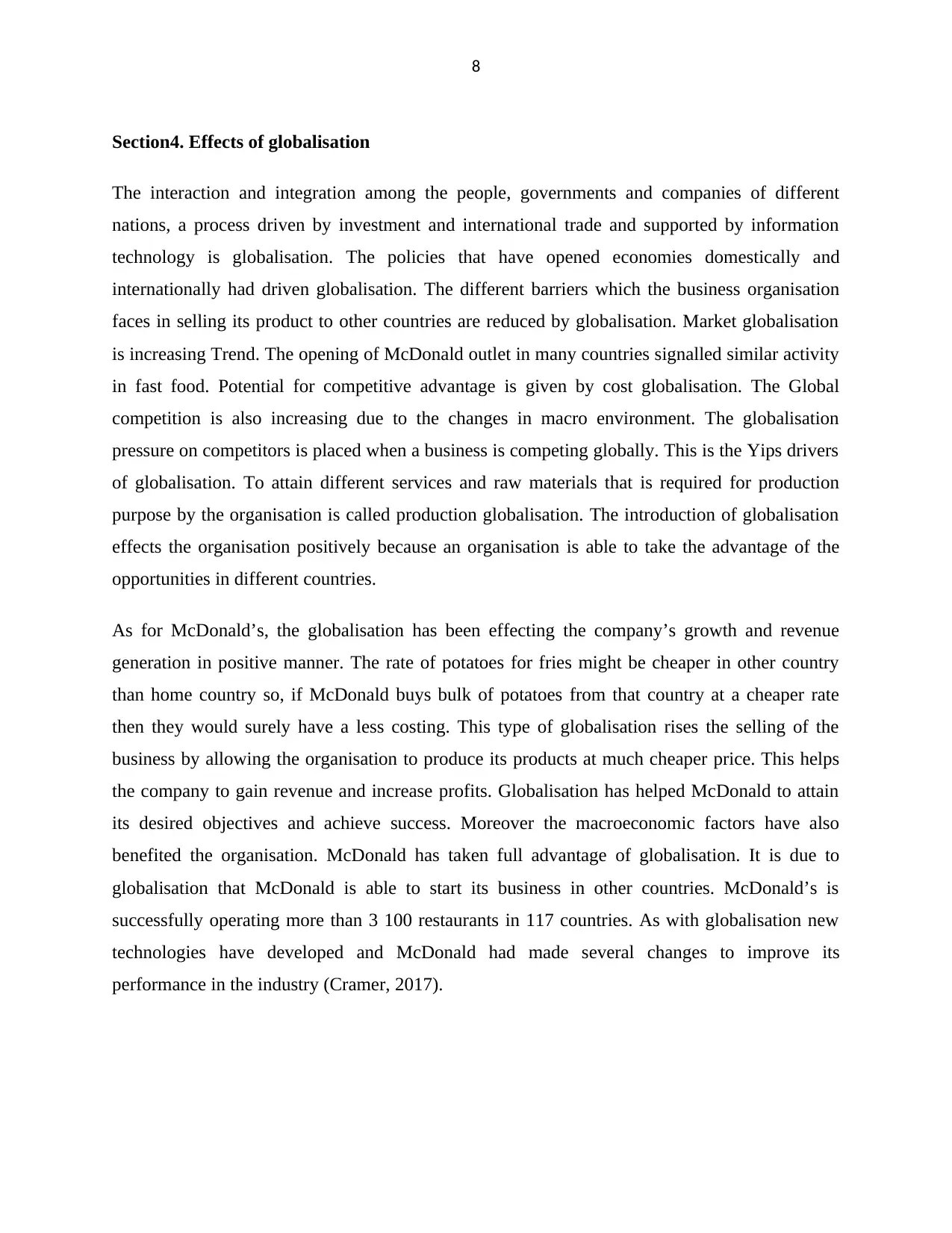
8
Section4. Effects of globalisation
The interaction and integration among the people, governments and companies of different
nations, a process driven by investment and international trade and supported by information
technology is globalisation. The policies that have opened economies domestically and
internationally had driven globalisation. The different barriers which the business organisation
faces in selling its product to other countries are reduced by globalisation. Market globalisation
is increasing Trend. The opening of McDonald outlet in many countries signalled similar activity
in fast food. Potential for competitive advantage is given by cost globalisation. The Global
competition is also increasing due to the changes in macro environment. The globalisation
pressure on competitors is placed when a business is competing globally. This is the Yips drivers
of globalisation. To attain different services and raw materials that is required for production
purpose by the organisation is called production globalisation. The introduction of globalisation
effects the organisation positively because an organisation is able to take the advantage of the
opportunities in different countries.
As for McDonald’s, the globalisation has been effecting the company’s growth and revenue
generation in positive manner. The rate of potatoes for fries might be cheaper in other country
than home country so, if McDonald buys bulk of potatoes from that country at a cheaper rate
then they would surely have a less costing. This type of globalisation rises the selling of the
business by allowing the organisation to produce its products at much cheaper price. This helps
the company to gain revenue and increase profits. Globalisation has helped McDonald to attain
its desired objectives and achieve success. Moreover the macroeconomic factors have also
benefited the organisation. McDonald has taken full advantage of globalisation. It is due to
globalisation that McDonald is able to start its business in other countries. McDonald’s is
successfully operating more than 3 100 restaurants in 117 countries. As with globalisation new
technologies have developed and McDonald had made several changes to improve its
performance in the industry (Cramer, 2017).
Section4. Effects of globalisation
The interaction and integration among the people, governments and companies of different
nations, a process driven by investment and international trade and supported by information
technology is globalisation. The policies that have opened economies domestically and
internationally had driven globalisation. The different barriers which the business organisation
faces in selling its product to other countries are reduced by globalisation. Market globalisation
is increasing Trend. The opening of McDonald outlet in many countries signalled similar activity
in fast food. Potential for competitive advantage is given by cost globalisation. The Global
competition is also increasing due to the changes in macro environment. The globalisation
pressure on competitors is placed when a business is competing globally. This is the Yips drivers
of globalisation. To attain different services and raw materials that is required for production
purpose by the organisation is called production globalisation. The introduction of globalisation
effects the organisation positively because an organisation is able to take the advantage of the
opportunities in different countries.
As for McDonald’s, the globalisation has been effecting the company’s growth and revenue
generation in positive manner. The rate of potatoes for fries might be cheaper in other country
than home country so, if McDonald buys bulk of potatoes from that country at a cheaper rate
then they would surely have a less costing. This type of globalisation rises the selling of the
business by allowing the organisation to produce its products at much cheaper price. This helps
the company to gain revenue and increase profits. Globalisation has helped McDonald to attain
its desired objectives and achieve success. Moreover the macroeconomic factors have also
benefited the organisation. McDonald has taken full advantage of globalisation. It is due to
globalisation that McDonald is able to start its business in other countries. McDonald’s is
successfully operating more than 3 100 restaurants in 117 countries. As with globalisation new
technologies have developed and McDonald had made several changes to improve its
performance in the industry (Cramer, 2017).
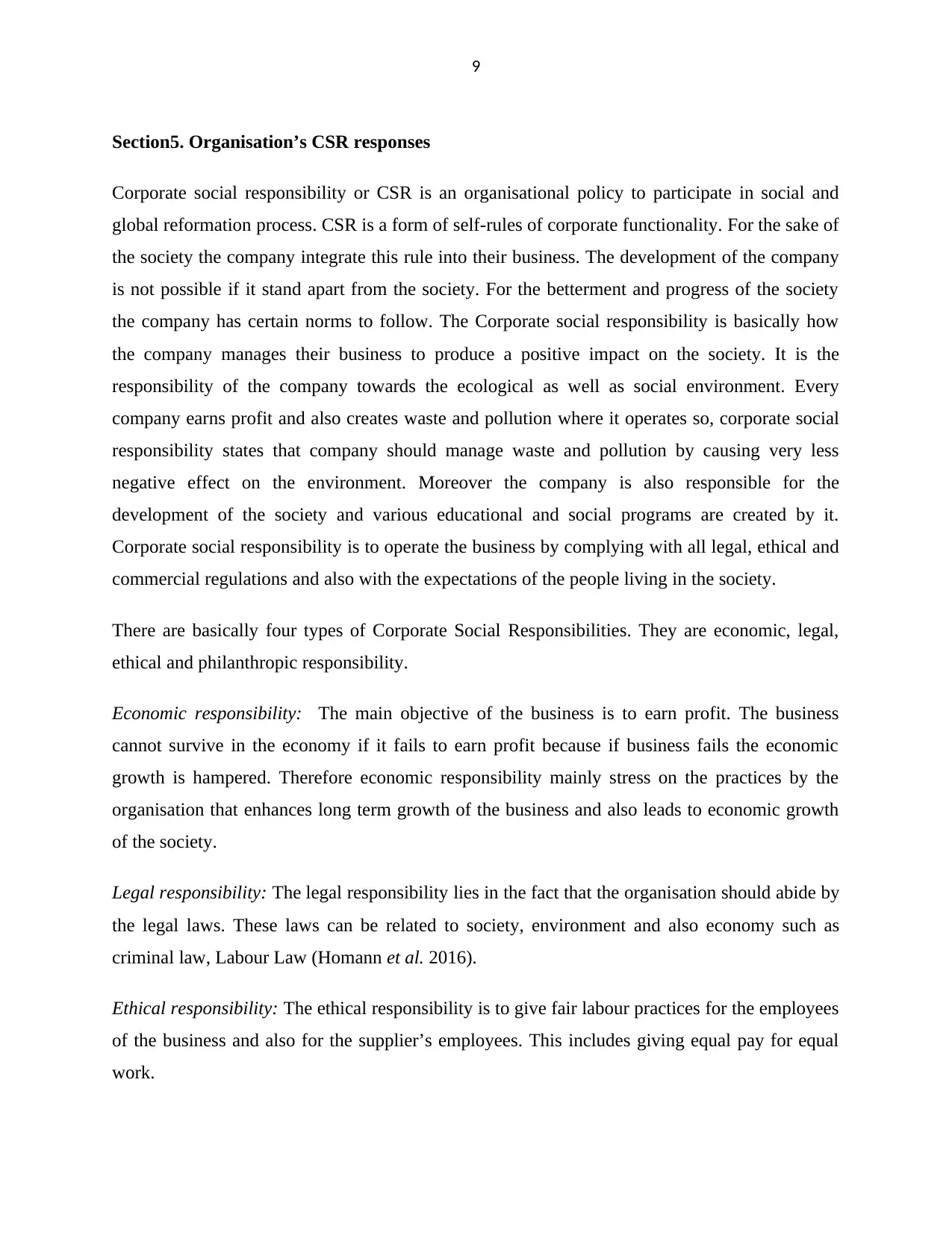
9
Section5. Organisation’s CSR responses
Corporate social responsibility or CSR is an organisational policy to participate in social and
global reformation process. CSR is a form of self-rules of corporate functionality. For the sake of
the society the company integrate this rule into their business. The development of the company
is not possible if it stand apart from the society. For the betterment and progress of the society
the company has certain norms to follow. The Corporate social responsibility is basically how
the company manages their business to produce a positive impact on the society. It is the
responsibility of the company towards the ecological as well as social environment. Every
company earns profit and also creates waste and pollution where it operates so, corporate social
responsibility states that company should manage waste and pollution by causing very less
negative effect on the environment. Moreover the company is also responsible for the
development of the society and various educational and social programs are created by it.
Corporate social responsibility is to operate the business by complying with all legal, ethical and
commercial regulations and also with the expectations of the people living in the society.
There are basically four types of Corporate Social Responsibilities. They are economic, legal,
ethical and philanthropic responsibility.
Economic responsibility: The main objective of the business is to earn profit. The business
cannot survive in the economy if it fails to earn profit because if business fails the economic
growth is hampered. Therefore economic responsibility mainly stress on the practices by the
organisation that enhances long term growth of the business and also leads to economic growth
of the society.
Legal responsibility: The legal responsibility lies in the fact that the organisation should abide by
the legal laws. These laws can be related to society, environment and also economy such as
criminal law, Labour Law (Homann et al. 2016).
Ethical responsibility: The ethical responsibility is to give fair labour practices for the employees
of the business and also for the supplier’s employees. This includes giving equal pay for equal
work.
Section5. Organisation’s CSR responses
Corporate social responsibility or CSR is an organisational policy to participate in social and
global reformation process. CSR is a form of self-rules of corporate functionality. For the sake of
the society the company integrate this rule into their business. The development of the company
is not possible if it stand apart from the society. For the betterment and progress of the society
the company has certain norms to follow. The Corporate social responsibility is basically how
the company manages their business to produce a positive impact on the society. It is the
responsibility of the company towards the ecological as well as social environment. Every
company earns profit and also creates waste and pollution where it operates so, corporate social
responsibility states that company should manage waste and pollution by causing very less
negative effect on the environment. Moreover the company is also responsible for the
development of the society and various educational and social programs are created by it.
Corporate social responsibility is to operate the business by complying with all legal, ethical and
commercial regulations and also with the expectations of the people living in the society.
There are basically four types of Corporate Social Responsibilities. They are economic, legal,
ethical and philanthropic responsibility.
Economic responsibility: The main objective of the business is to earn profit. The business
cannot survive in the economy if it fails to earn profit because if business fails the economic
growth is hampered. Therefore economic responsibility mainly stress on the practices by the
organisation that enhances long term growth of the business and also leads to economic growth
of the society.
Legal responsibility: The legal responsibility lies in the fact that the organisation should abide by
the legal laws. These laws can be related to society, environment and also economy such as
criminal law, Labour Law (Homann et al. 2016).
Ethical responsibility: The ethical responsibility is to give fair labour practices for the employees
of the business and also for the supplier’s employees. This includes giving equal pay for equal
work.
⊘ This is a preview!⊘
Do you want full access?
Subscribe today to unlock all pages.

Trusted by 1+ million students worldwide
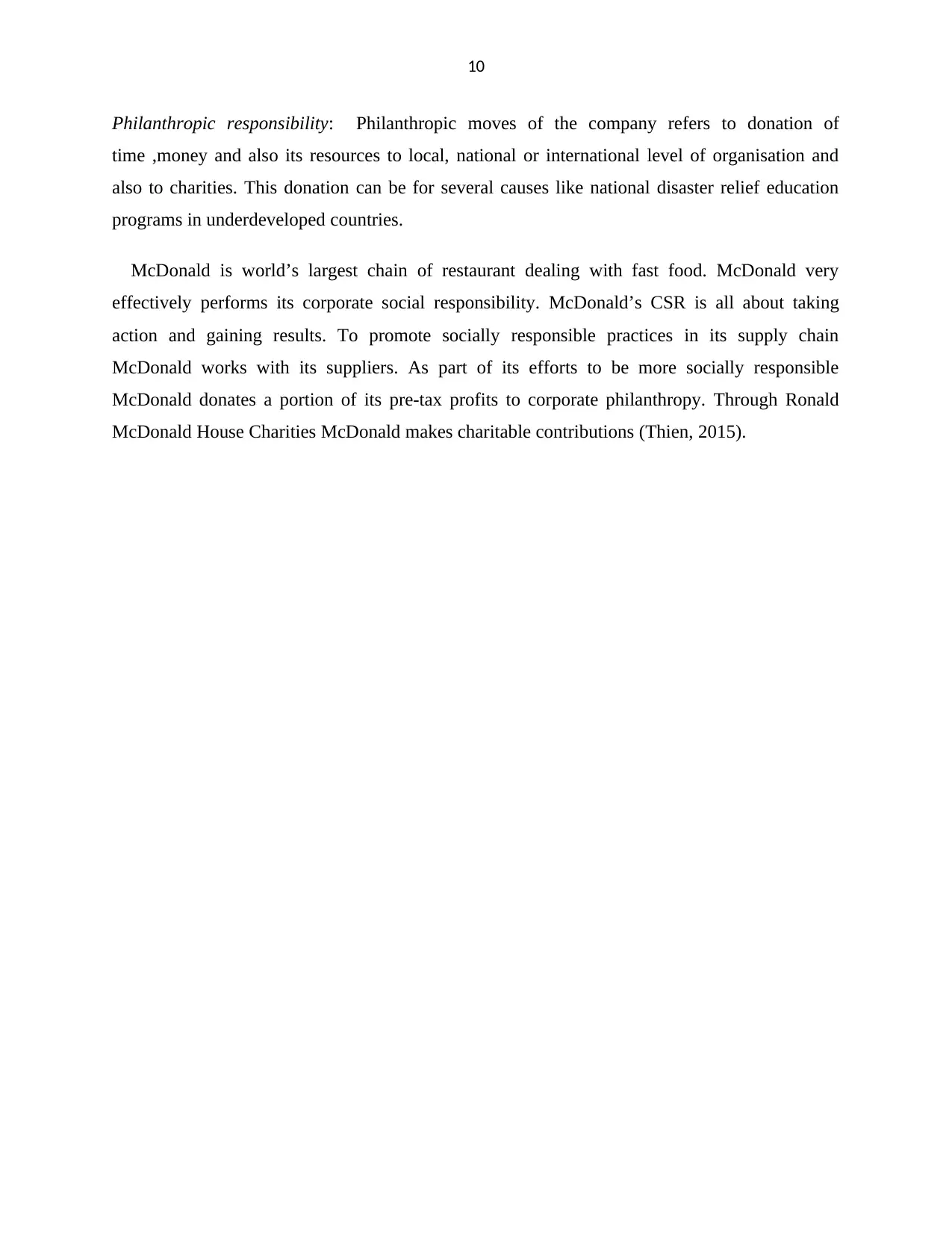
10
Philanthropic responsibility: Philanthropic moves of the company refers to donation of
time ,money and also its resources to local, national or international level of organisation and
also to charities. This donation can be for several causes like national disaster relief education
programs in underdeveloped countries.
McDonald is world’s largest chain of restaurant dealing with fast food. McDonald very
effectively performs its corporate social responsibility. McDonald’s CSR is all about taking
action and gaining results. To promote socially responsible practices in its supply chain
McDonald works with its suppliers. As part of its efforts to be more socially responsible
McDonald donates a portion of its pre-tax profits to corporate philanthropy. Through Ronald
McDonald House Charities McDonald makes charitable contributions (Thien, 2015).
Philanthropic responsibility: Philanthropic moves of the company refers to donation of
time ,money and also its resources to local, national or international level of organisation and
also to charities. This donation can be for several causes like national disaster relief education
programs in underdeveloped countries.
McDonald is world’s largest chain of restaurant dealing with fast food. McDonald very
effectively performs its corporate social responsibility. McDonald’s CSR is all about taking
action and gaining results. To promote socially responsible practices in its supply chain
McDonald works with its suppliers. As part of its efforts to be more socially responsible
McDonald donates a portion of its pre-tax profits to corporate philanthropy. Through Ronald
McDonald House Charities McDonald makes charitable contributions (Thien, 2015).
Paraphrase This Document
Need a fresh take? Get an instant paraphrase of this document with our AI Paraphraser
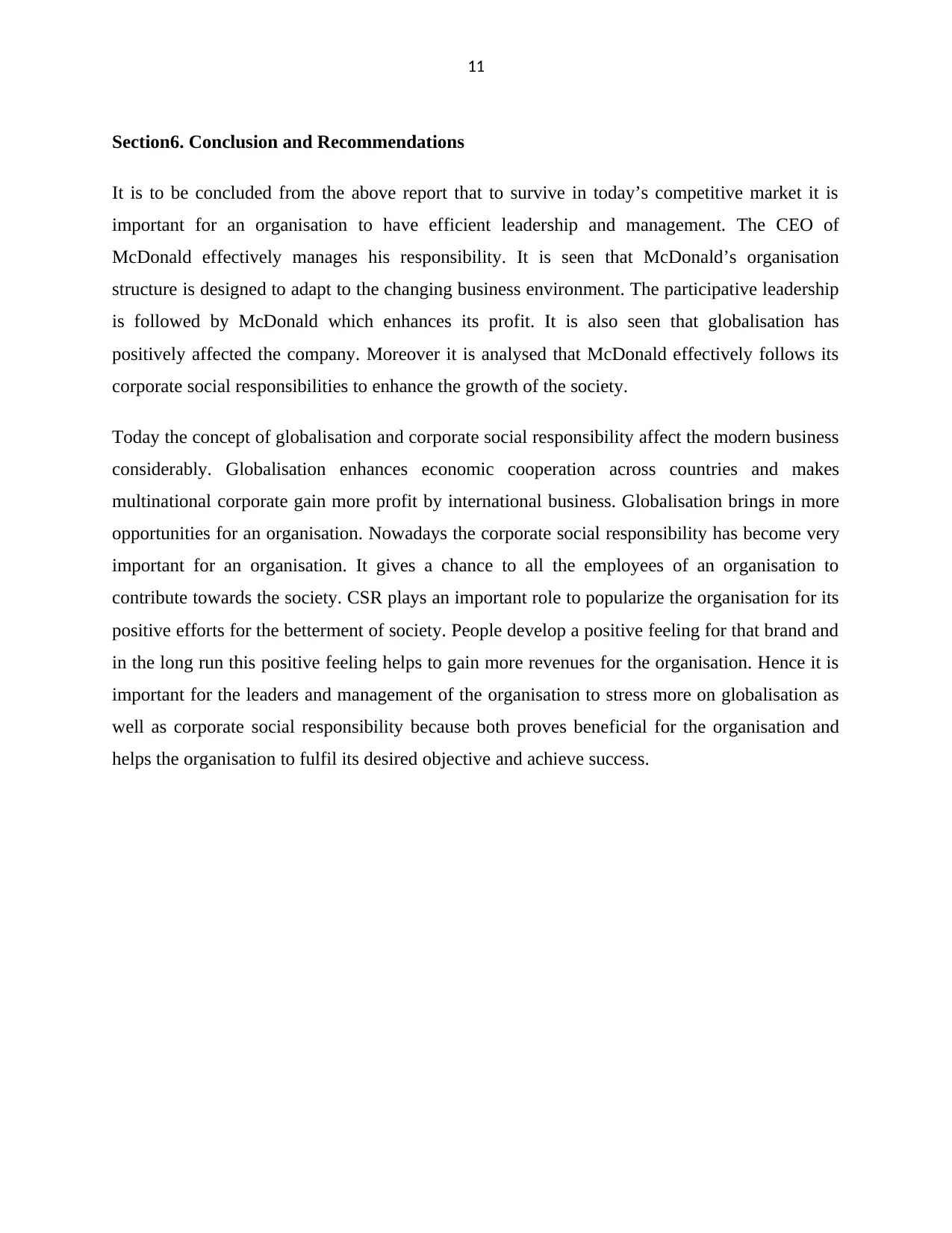
11
Section6. Conclusion and Recommendations
It is to be concluded from the above report that to survive in today’s competitive market it is
important for an organisation to have efficient leadership and management. The CEO of
McDonald effectively manages his responsibility. It is seen that McDonald’s organisation
structure is designed to adapt to the changing business environment. The participative leadership
is followed by McDonald which enhances its profit. It is also seen that globalisation has
positively affected the company. Moreover it is analysed that McDonald effectively follows its
corporate social responsibilities to enhance the growth of the society.
Today the concept of globalisation and corporate social responsibility affect the modern business
considerably. Globalisation enhances economic cooperation across countries and makes
multinational corporate gain more profit by international business. Globalisation brings in more
opportunities for an organisation. Nowadays the corporate social responsibility has become very
important for an organisation. It gives a chance to all the employees of an organisation to
contribute towards the society. CSR plays an important role to popularize the organisation for its
positive efforts for the betterment of society. People develop a positive feeling for that brand and
in the long run this positive feeling helps to gain more revenues for the organisation. Hence it is
important for the leaders and management of the organisation to stress more on globalisation as
well as corporate social responsibility because both proves beneficial for the organisation and
helps the organisation to fulfil its desired objective and achieve success.
Section6. Conclusion and Recommendations
It is to be concluded from the above report that to survive in today’s competitive market it is
important for an organisation to have efficient leadership and management. The CEO of
McDonald effectively manages his responsibility. It is seen that McDonald’s organisation
structure is designed to adapt to the changing business environment. The participative leadership
is followed by McDonald which enhances its profit. It is also seen that globalisation has
positively affected the company. Moreover it is analysed that McDonald effectively follows its
corporate social responsibilities to enhance the growth of the society.
Today the concept of globalisation and corporate social responsibility affect the modern business
considerably. Globalisation enhances economic cooperation across countries and makes
multinational corporate gain more profit by international business. Globalisation brings in more
opportunities for an organisation. Nowadays the corporate social responsibility has become very
important for an organisation. It gives a chance to all the employees of an organisation to
contribute towards the society. CSR plays an important role to popularize the organisation for its
positive efforts for the betterment of society. People develop a positive feeling for that brand and
in the long run this positive feeling helps to gain more revenues for the organisation. Hence it is
important for the leaders and management of the organisation to stress more on globalisation as
well as corporate social responsibility because both proves beneficial for the organisation and
helps the organisation to fulfil its desired objective and achieve success.
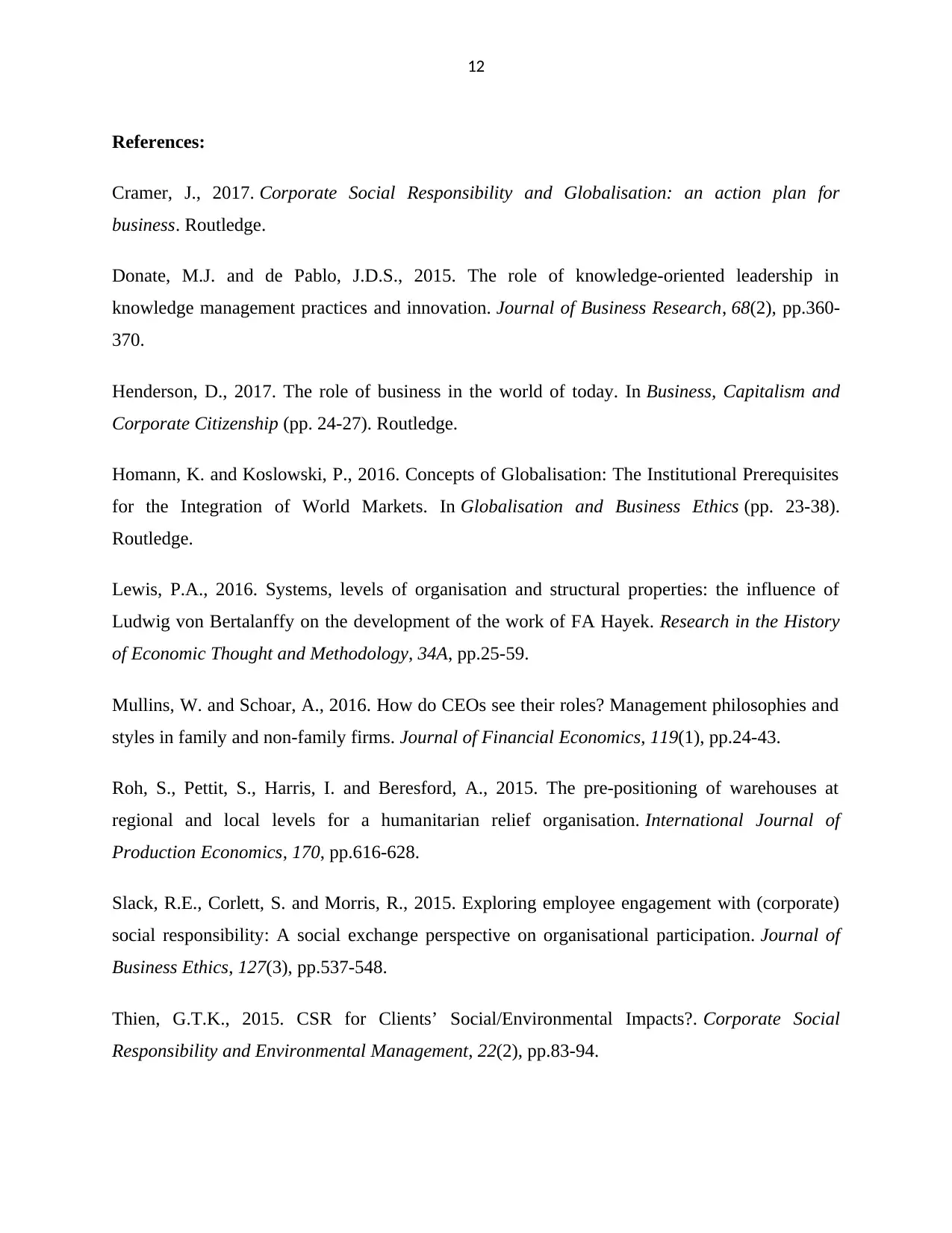
12
References:
Cramer, J., 2017. Corporate Social Responsibility and Globalisation: an action plan for
business. Routledge.
Donate, M.J. and de Pablo, J.D.S., 2015. The role of knowledge-oriented leadership in
knowledge management practices and innovation. Journal of Business Research, 68(2), pp.360-
370.
Henderson, D., 2017. The role of business in the world of today. In Business, Capitalism and
Corporate Citizenship (pp. 24-27). Routledge.
Homann, K. and Koslowski, P., 2016. Concepts of Globalisation: The Institutional Prerequisites
for the Integration of World Markets. In Globalisation and Business Ethics (pp. 23-38).
Routledge.
Lewis, P.A., 2016. Systems, levels of organisation and structural properties: the influence of
Ludwig von Bertalanffy on the development of the work of FA Hayek. Research in the History
of Economic Thought and Methodology, 34A, pp.25-59.
Mullins, W. and Schoar, A., 2016. How do CEOs see their roles? Management philosophies and
styles in family and non-family firms. Journal of Financial Economics, 119(1), pp.24-43.
Roh, S., Pettit, S., Harris, I. and Beresford, A., 2015. The pre-positioning of warehouses at
regional and local levels for a humanitarian relief organisation. International Journal of
Production Economics, 170, pp.616-628.
Slack, R.E., Corlett, S. and Morris, R., 2015. Exploring employee engagement with (corporate)
social responsibility: A social exchange perspective on organisational participation. Journal of
Business Ethics, 127(3), pp.537-548.
Thien, G.T.K., 2015. CSR for Clients’ Social/Environmental Impacts?. Corporate Social
Responsibility and Environmental Management, 22(2), pp.83-94.
References:
Cramer, J., 2017. Corporate Social Responsibility and Globalisation: an action plan for
business. Routledge.
Donate, M.J. and de Pablo, J.D.S., 2015. The role of knowledge-oriented leadership in
knowledge management practices and innovation. Journal of Business Research, 68(2), pp.360-
370.
Henderson, D., 2017. The role of business in the world of today. In Business, Capitalism and
Corporate Citizenship (pp. 24-27). Routledge.
Homann, K. and Koslowski, P., 2016. Concepts of Globalisation: The Institutional Prerequisites
for the Integration of World Markets. In Globalisation and Business Ethics (pp. 23-38).
Routledge.
Lewis, P.A., 2016. Systems, levels of organisation and structural properties: the influence of
Ludwig von Bertalanffy on the development of the work of FA Hayek. Research in the History
of Economic Thought and Methodology, 34A, pp.25-59.
Mullins, W. and Schoar, A., 2016. How do CEOs see their roles? Management philosophies and
styles in family and non-family firms. Journal of Financial Economics, 119(1), pp.24-43.
Roh, S., Pettit, S., Harris, I. and Beresford, A., 2015. The pre-positioning of warehouses at
regional and local levels for a humanitarian relief organisation. International Journal of
Production Economics, 170, pp.616-628.
Slack, R.E., Corlett, S. and Morris, R., 2015. Exploring employee engagement with (corporate)
social responsibility: A social exchange perspective on organisational participation. Journal of
Business Ethics, 127(3), pp.537-548.
Thien, G.T.K., 2015. CSR for Clients’ Social/Environmental Impacts?. Corporate Social
Responsibility and Environmental Management, 22(2), pp.83-94.
⊘ This is a preview!⊘
Do you want full access?
Subscribe today to unlock all pages.

Trusted by 1+ million students worldwide
1 out of 13
Related Documents
Your All-in-One AI-Powered Toolkit for Academic Success.
+13062052269
info@desklib.com
Available 24*7 on WhatsApp / Email
![[object Object]](/_next/static/media/star-bottom.7253800d.svg)
Unlock your academic potential
Copyright © 2020–2025 A2Z Services. All Rights Reserved. Developed and managed by ZUCOL.




